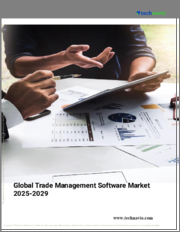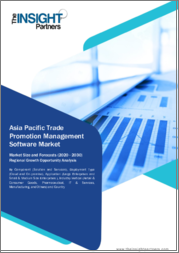
|
시장보고서
상품코드
1663890
무역 관리 소프트웨어 시장 규모, 점유율, 성장 분석 : 배포별, 기능별, 기업 유형별, 산업별, 지역별 - 산업 예측(2025-2032년)Trade Management Software Market Size, Share, and Growth Analysis, By Deployment (On-premise, Cloud), By Function (Trade Compliance, Customs Management), By Enterprise Type, By Industry, By Region - Industry Forecast 2025-2032 |
||||||
무역 관리 소프트웨어 시장 규모는 2023년에 20억 9,000만 달러로 평가되며, 2024년 22억 7,000만 달러에서 2032년에는 44억 3,000만 달러로 성장하며, 예측 기간(2025-2032년)의 CAGR은 8.7%로 성장할 전망입니다.
세계의 무역 관리 소프트웨어 시장은 무역 규제, 관세, 통관 절차의 복잡성으로 인해 크게 성장하고 있습니다. 비즈니스의 세계화에 따라 국경을 넘나드는 복잡한 공급망을 탐색하기 위해 효율적인 무역 관리 솔루션의 필요성이 가장 중요해지고 있습니다. 그러나 소프트웨어 구입, 커스터마이징, 통합, 유지보수, 지속적인 지원을 포함한 높은 도입 비용은 특히 중소기업에게 큰 부담으로 작용하고 있습니다. 무역관리시스템(TMS) 도입의 경제적 부담에는 직원 교육 및 시스템 업그레이드에 대한 추가 비용도 포함됩니다. 동시에 시장 성장을 가속하는 요인으로는 진화하는 무역 규정 준수, 업무 효율성 향상, AI 및 머신러닝과 같은 첨단 기술의 통합 등이 있습니다. 이러한 융합은 종합적이고 자동화된 무역 관리 솔루션에 대한 수요를 증가시켜 공급망 최적화를 혁신적으로 변화시킬 준비가 되어 있습니다.
목차
서론
- 조사의 목적
- 조사 범위
- 정의
조사 방법
- 정보 조달
- 2차와 1차 데이터 방법
- 시장 규모 예측
- 시장의 전제조건과 제한
개요
- 세계 시장 전망
- 공급과 수요 동향 분석
- 부문별 기회 분석
시장 역학과 전망
- 시장 개요
- 시장 규모
- 시장 역학
- 촉진요인과 기회
- 억제요인과 과제
- Porter의 산업 분석
주요 시장 인사이트
- 주요 성공 요인
- 경쟁의 정도
- 주요 투자 기회
- 시장 에코시스템
- 시장의 매력 지수(2024년)
- PESTEL 분석
- 거시경제 지표
- 밸류체인 분석
- 가격 분석
- 사례 연구
- 기술의 진보
- 규제 상황
- 특허 분석
무역 관리 소프트웨어 시장 규모 : 배포별 & CAGR(2025-2032)
- 시장 개요
- 온프레미스
- 클라우드
무역 관리 소프트웨어 시장 규모 : 기능별 & CAGR(2025-2032)
- 시장 개요
- 무역 컴플라이언스
- 통관 관리
- 재무 관리
- 트레이드 분석
- 기타
무역 관리 소프트웨어 시장 규모 : 기업 유형별 & CAGR(2025-2032)
- 시장 개요
- 중소기업
- 대기업
무역 관리 소프트웨어 시장 규모 : 산업별 & CAGR(2025-2032)
- 시장 개요
- 자동차
- 헬스케어와 생명과학
- 제조업
- 운송·물류
- IT 및 통신
- 소매·소비재
- 기타
무역 관리 소프트웨어 시장 규모 : 지역별 & CAGR(2025-2032)
- 북미
- 미국
- 캐나다
- 유럽
- 독일
- 스페인
- 프랑스
- 영국
- 이탈리아
- 기타 유럽 지역
- 아시아태평양
- 중국
- 인도
- 일본
- 한국
- 기타 아시아태평양
- 라틴아메리카
- 브라질
- 기타 라틴아메리카 지역
- 중동 및 아프리카
- GCC 국가
- 남아프리카공화국
- 기타 중동 및 아프리카
경쟁 정보
- 상위 5사의 비교
- 주요 기업의 시장 포지셔닝(2024년)
- 주요 시장 기업이 채택한 전략
- 최근 시장 동향
- 기업의 시장 점유율 분석(2024년)
- 주요 기업의 기업 개요
- 기업의 상세
- 제품 포트폴리오 분석
- 기업의 부문별 점유율 분석
- 매출의 전년대비 비교(2022-2024)
주요 기업 개요
- Amber Road, Inc.(USA)
- Aptean, Inc.(USA)
- Livingston International, Inc.(Canada)
- MIC Customs Solutions(Austria)
- MIQ Logistics LLC(USA)
- Precision Software(USA)
- SAP SE(Germany)
- Oracle Corporation(USA)
- Descartes Systems Group Inc.(Canada)
- Infor(USA)
- Integration Point, Inc.(USA)
- QuestaWeb, Inc.(USA)
- BluJay Solutions Ltd.(UK)
- MercuryGate International, Inc.(USA)
- Thomson Reuters Corporation(Canada)
- Kewill, Inc.(USA)
- TradeBeam, Inc.(USA)
- AEB SE(Germany)
- WiseTech Global(Australia)
- E2open, LLC(USA)
결론과 제안
KSA 25.04.01Trade Management Software Market size was valued at USD 2.09 billion in 2023 and is poised to grow from USD 2.27 billion in 2024 to USD 4.43 billion by 2032, growing at a CAGR of 8.7% during the forecast period (2025-2032).
The global trade management software market is witnessing significant growth due to the rising complexity of trade regulations, tariffs, and customs procedures. As businesses globalize, the need for efficient trade management solutions becomes paramount for navigating intricate supply chains across borders. However, high implementation costs, encompassing software acquisition, customization, integration, maintenance, and ongoing support, pose challenges, particularly for SMEs. The financial burden of adopting a Trade Management System (TMS) can include additional expenses for staff training and system upgrades. Simultaneously, drivers of market growth include the necessity for compliance with evolving trade regulations, enhanced operational efficiencies, and the integration of advanced technologies like AI and machine learning. This convergence is leading to increased demand for comprehensive, automated trade management solutions, poised to transform supply chain optimization.
Top-down and bottom-up approaches were used to estimate and validate the size of the Trade Management Software market and to estimate the size of various other dependent submarkets. The research methodology used to estimate the market size includes the following details: The key players in the market were identified through secondary research, and their market shares in the respective regions were determined through primary and secondary research. This entire procedure includes the study of the annual and financial reports of the top market players and extensive interviews for key insights from industry leaders such as CEOs, VPs, directors, and marketing executives. All percentage shares split, and breakdowns were determined using secondary sources and verified through Primary sources. All possible parameters that affect the markets covered in this research study have been accounted for, viewed in extensive detail, verified through primary research, and analyzed to get the final quantitative and qualitative data.
Trade Management Software Market Segments Analysis
Global Trade Management Software Market is segmented by Deployment, Function, Enterprise Type, Industry and region. Based on Deployment, the market is segmented into On-premise and Cloud. Based on Function, the market is segmented into Trade Compliance, Customs Management, Finance Management, Trade Analytics and Others. Based on Enterprise Type, the market is segmented into SMEs and Large Enterprises. Based on Industry, the market is segmented into Automotive, Healthcare & Life Sciences, Manufacturing, Transportation & Logistics, IT & Telecom, Retail & Consumer Goods and Others. Based on region, the market is segmented into North America, Europe, Asia Pacific, Latin America and Middle East & Africa.
Driver of the Trade Management Software Market
The adoption of generative AI significantly contributes to the expansion of numerous supply chain applications, such as risk management, logistics oversight, trade network coordination, supplier relations, production planning, demand forecasting, and vendor negotiations. This broad scope of supply chain operations worldwide presents substantial opportunities for businesses to leverage generative AI, ultimately driving improvement and efficiency in their processes. As organizations increasingly recognize the transformative potential of this technology, they are more likely to integrate it into their trade management software, leading to enhanced performance and competitiveness in the market.
Restraints in the Trade Management Software Market
The Trade Management Software market faces significant constraints due to geopolitical events that are reshaping the risk and compliance landscape. Organizations across various sectors must stay vigilant and adapt to these evolving circumstances that influence trade authorizations and compliance obligations. For instance, existing agreements with Russia can no longer be upheld, and continuous updates to trade and compliance standards can emerge without warning. As a result, businesses must navigate an increasingly complex environment, requiring them to reassess their strategies and tools to ensure they remain compliant with the changing regulations and geopolitical dynamics that impact their operations.
Market Trends of the Trade Management Software Market
The Trade Management Software market is witnessing a significant trend towards advanced integrated solutions, where software is increasingly being harmonized with CRM, ERP, risk management, and invoicing systems. This integration enhances enterprise productivity, optimizes user experience, and facilitates regulatory compliance while bolstering decision-making capabilities. Market players are emphasizing the development of innovative solutions that offer seamless connectivity across various platforms, enabling businesses to expand their operational efficiencies and refine their trade strategies. As companies aim for streamlined processes and improved functionality, the demand for such integrated trade management solutions is poised for substantial growth in the coming years.
Table of Contents
Introduction
- Objectives of the Study
- Scope of the Report
- Definitions
Research Methodology
- Information Procurement
- Secondary & Primary Data Methods
- Market Size Estimation
- Market Assumptions & Limitations
Executive Summary
- Global Market Outlook
- Supply & Demand Trend Analysis
- Segmental Opportunity Analysis
Market Dynamics & Outlook
- Market Overview
- Market Size
- Market Dynamics
- Drivers & Opportunities
- Restraints & Challenges
- Porters Analysis
- Competitive rivalry
- Threat of substitute
- Bargaining power of buyers
- Threat of new entrants
- Bargaining power of suppliers
Key Market Insights
- Key Success Factors
- Degree of Competition
- Top Investment Pockets
- Market Ecosystem
- Market Attractiveness Index, 2024
- PESTEL Analysis
- Macro-Economic Indicators
- Value Chain Analysis
- Pricing Analysis
- Case Studies
- Technology Advancement
- Regulatory Landscape
- Patent Analysis
Global Trade Management Software Market Size by Deployment & CAGR (2025-2032)
- Market Overview
- On-premise
- Cloud
Global Trade Management Software Market Size by Function & CAGR (2025-2032)
- Market Overview
- Trade Compliance
- Customs Management
- Finance Management
- Trade Analytics
- Others
Global Trade Management Software Market Size by Enterprise Type & CAGR (2025-2032)
- Market Overview
- SMEs
- Large Enterprises
Global Trade Management Software Market Size by Industry & CAGR (2025-2032)
- Market Overview
- Automotive
- Healthcare & Life Sciences
- Manufacturing
- Transportation & Logistics
- IT & Telecom
- Retail & Consumer Goods
- Others
Global Trade Management Software Market Size & CAGR (2025-2032)
- North America (Deployment, Function, Enterprise Type, Industry)
- US
- Canada
- Europe (Deployment, Function, Enterprise Type, Industry)
- Germany
- Spain
- France
- UK
- Italy
- Rest of Europe
- Asia Pacific (Deployment, Function, Enterprise Type, Industry)
- China
- India
- Japan
- South Korea
- Rest of Asia-Pacific
- Latin America (Deployment, Function, Enterprise Type, Industry)
- Brazil
- Rest of Latin America
- Middle East & Africa (Deployment, Function, Enterprise Type, Industry)
- GCC Countries
- South Africa
- Rest of Middle East & Africa
Competitive Intelligence
- Top 5 Player Comparison
- Market Positioning of Key Players, 2024
- Strategies Adopted by Key Market Players
- Recent Developments in the Market
- Company Market Share Analysis, 2024
- Company Profiles of All Key Players
- Company Details
- Product Portfolio Analysis
- Company's Segmental Share Analysis
- Revenue Y-O-Y Comparison (2022-2024)
Key Company Profiles
- Amber Road, Inc. (USA)
- Company Overview
- Business Segment Overview
- Financial Updates
- Key Developments
- Aptean, Inc. (USA)
- Company Overview
- Business Segment Overview
- Financial Updates
- Key Developments
- Livingston International, Inc. (Canada)
- Company Overview
- Business Segment Overview
- Financial Updates
- Key Developments
- MIC Customs Solutions (Austria)
- Company Overview
- Business Segment Overview
- Financial Updates
- Key Developments
- MIQ Logistics LLC (USA)
- Company Overview
- Business Segment Overview
- Financial Updates
- Key Developments
- Precision Software (USA)
- Company Overview
- Business Segment Overview
- Financial Updates
- Key Developments
- SAP SE (Germany)
- Company Overview
- Business Segment Overview
- Financial Updates
- Key Developments
- Oracle Corporation (USA)
- Company Overview
- Business Segment Overview
- Financial Updates
- Key Developments
- Descartes Systems Group Inc. (Canada)
- Company Overview
- Business Segment Overview
- Financial Updates
- Key Developments
- Infor (USA)
- Company Overview
- Business Segment Overview
- Financial Updates
- Key Developments
- Integration Point, Inc. (USA)
- Company Overview
- Business Segment Overview
- Financial Updates
- Key Developments
- QuestaWeb, Inc. (USA)
- Company Overview
- Business Segment Overview
- Financial Updates
- Key Developments
- BluJay Solutions Ltd. (UK)
- Company Overview
- Business Segment Overview
- Financial Updates
- Key Developments
- MercuryGate International, Inc. (USA)
- Company Overview
- Business Segment Overview
- Financial Updates
- Key Developments
- Thomson Reuters Corporation (Canada)
- Company Overview
- Business Segment Overview
- Financial Updates
- Key Developments
- Kewill, Inc. (USA)
- Company Overview
- Business Segment Overview
- Financial Updates
- Key Developments
- TradeBeam, Inc. (USA)
- Company Overview
- Business Segment Overview
- Financial Updates
- Key Developments
- AEB SE (Germany)
- Company Overview
- Business Segment Overview
- Financial Updates
- Key Developments
- WiseTech Global (Australia)
- Company Overview
- Business Segment Overview
- Financial Updates
- Key Developments
- E2open, LLC (USA)
- Company Overview
- Business Segment Overview
- Financial Updates
- Key Developments



















